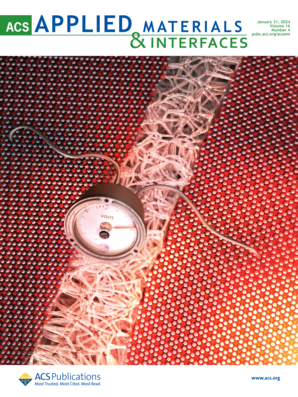Complexity at a Humid Interface: Throwing Fresh Light on Atmospheric Corrosion
IF 8.3
2区 材料科学
Q1 MATERIALS SCIENCE, MULTIDISCIPLINARY
引用次数: 0
Abstract
Atmospheric corrosion of metals arising from exposure to water vapor is a pervasive problem across a wide range of practical scenarios, including nuclear material storage and historical artifact conservation. Frequently, it is hypothesized that this phenomenon becomes an issue once the number of monolayers of water growing atop a substrate is sufficient to facilitate corrosion chemistry, but supporting evidence remains scarce. We apply both near ambient pressure X-ray photoelectron spectroscopy and vibrational sum frequency spectroscopy to further elucidate the interaction of water vapor with zinc, a common engineering substrate for corrosion protection applications. Data acquired as a function of relative humidity indicate that water sorption is much more complex than expected, involving micropore filling and capillary condensation in the adventitious carbon layer covering the zinc surface. These results suggest that current mechanistic models for atmospheric corrosion, as well as other interfacial phenomena occurring in humid environments, require extensive revision and should embrace explicit consideration of the role of surface carbon contamination.

潮湿界面的复杂性:对大气腐蚀的新认识
由于暴露于水蒸气而引起的金属大气腐蚀是一个普遍存在的问题,在广泛的实际情况下,包括核材料储存和历史文物保护。通常,人们假设,一旦在基底上生长的单层水的数量足以促进腐蚀化学,这种现象就会成为一个问题,但支持的证据仍然很少。我们使用近环境压力x射线光电子能谱和振动和频率能谱来进一步阐明水蒸气与锌的相互作用,锌是一种用于防腐应用的常见工程衬底。作为相对湿度函数的数据表明,水的吸附过程比预期的要复杂得多,包括覆盖在锌表面的非定形碳层的微孔填充和毛细凝结。这些结果表明,目前的大气腐蚀机制模型,以及在潮湿环境中发生的其他界面现象,需要进行广泛的修订,并应明确考虑表面碳污染的作用。
本文章由计算机程序翻译,如有差异,请以英文原文为准。
求助全文
约1分钟内获得全文
求助全文
来源期刊

ACS Applied Materials & Interfaces
工程技术-材料科学:综合
CiteScore
16.00
自引率
6.30%
发文量
4978
审稿时长
1.8 months
期刊介绍:
ACS Applied Materials & Interfaces is a leading interdisciplinary journal that brings together chemists, engineers, physicists, and biologists to explore the development and utilization of newly-discovered materials and interfacial processes for specific applications. Our journal has experienced remarkable growth since its establishment in 2009, both in terms of the number of articles published and the impact of the research showcased. We are proud to foster a truly global community, with the majority of published articles originating from outside the United States, reflecting the rapid growth of applied research worldwide.
 求助内容:
求助内容: 应助结果提醒方式:
应助结果提醒方式:


